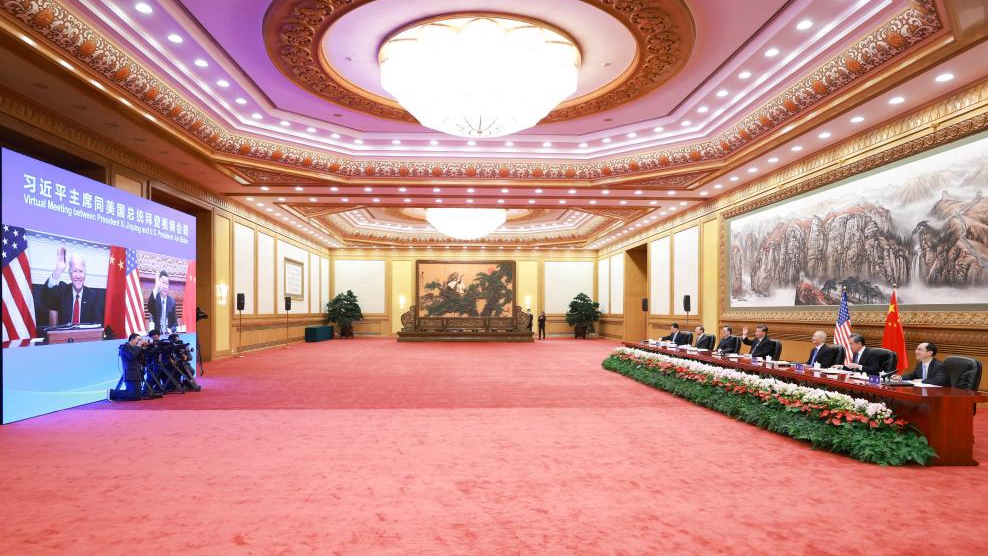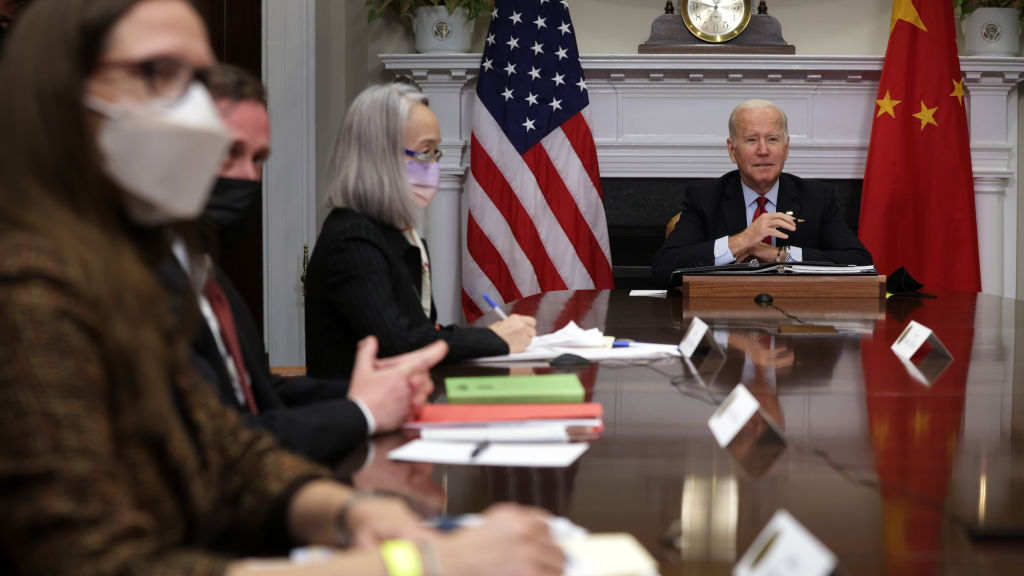
Chinese President Xi Jinping meets with U.S. President Joe Biden via video link in the Great Hall of the People, Beijing, capital of China, November 16, 2021. /Xinhua
Chinese President Xi Jinping meets with U.S. President Joe Biden via video link in the Great Hall of the People, Beijing, capital of China, November 16, 2021. /Xinhua
Editor's note: James Rae, a professor at California State University Sacramento, was a Fulbright Scholar at Beijing Foreign Studies University from 2017 to 2018. The article reflects the author's opinions and not necessarily the views of CGTN.
Chinese President Xi Jinping and U.S. President Joe Biden had their first formal virtual meeting on November 16 in Beijing and November 15 in Washington, D.C. Of course, this was made possible by the new modality of video conference call, and despite the time difference, it comes at a critical juncture in U.S.-China relations. American aggressiveness that began under the last administration has continued with full force under the new one.
In particular, the United States has sought much greater intrusion into China's domestic sovereignty issues and crossed some long-held red lines in doing so. This approach was also evident from the introductory remarks made by the U.S. president, and therefore we cannot expect too much change from this nevertheless important diplomatic moment.
High-level talks this past spring and summer between the two nations were rather prickly, with clear and frank discussions over numerous contentious topics and Chinese delegates admonishing the disrespectful attitude of their American counterparts. Of course, at the head-of-state level, diplomatic niceties are de rigueur and the two presidents followed such protocols. Both spoke admiringly of their past relationship, indeed friendship, and struck a cordial tone in their virtual dialogue. One area nonetheless stands out, and it is embedded in the diplomatic tone and ultimately foreign policy posture of each state. The U.S. imagines it is reacting to an aggressive China while China perceives defensive measures toward the American hegemonic force.
The words of both presidents serve as evidence of the underlying approach of both countries. President Xi emphasized "communication and cooperation." He said, "China and the U.S. need to increase communication and cooperation, each run their domestic affairs well and, at the same time, shoulder their share of international responsibilities, and work together to advance the noble cause of world peace and development."

U.S. President Joe Biden participates in a virtual meeting with Chinese President Xi Jinping in the White House, Washington, D.C., November 15, 2021. /Getty
U.S. President Joe Biden participates in a virtual meeting with Chinese President Xi Jinping in the White House, Washington, D.C., November 15, 2021. /Getty
Meanwhile, President Biden's team prioritized directly addressing the relationship as a "straightforward competition" and to make it clear from both sides that is the new reality, despite suggestions of building "guardrails" to prevent open conflict. Out of their fears and suspicion, American foreign policy practitioners almost always find enemies where none exist, or missile gaps where no lag is present; their distrust lends itself to aggressive outcomes.
In reality, the U.S. has been escalating the tensions over the past several years and the Biden administration has marched stridently along that road, particularly over the Taiwan question. The United States has wavered in its half-century commitment to the one-China principle as well as its strategic ambiguity toward its defense posture on the Taiwan Straits. A series of diplomatic measures and armed forces deployments have upset this fragile arrangement and risk upsetting the overall bilateral relationship altogether. The Chinese foreign policy team has been forced to remind the Americans of the status quo commitments that bind the relationship and of the formal position of the U.S. that recognizes the territorial unity of China. It is really not an issue to play with and must be understood as such.
Meanwhile, President Xi reiterated China's long-held emphasis on mutual respect, building consensus and moving U.S.-China relations forward in a positive manner. Many areas of harmony exist in foreign policy, most notably in the recent reaffirmation of shared commitments to counter climate change and global warming. If the U.S. wants to make China's internal affairs its highest foreign policy priority, relations will quickly fray and deteriorate with all the implications for the global economy and global governance. Hopefully, the American team will listen carefully to what President Xi is telling them. The Chinese delegations this year have been straightforward in attempting to correct American "errors" and underlining clearly its "three bottom lines" related to China's domestic sovereignty issues. Yet the Americans cannot keep their hands off these hot-button issues, perhaps President Biden will be more circumspect.
Hopefully, this summit harkens back to the great moments in the bilateral partnership when leaders from both sides saw the value in cooperation and restarts a more equitable and respectful dialogue between the two most important countries in contemporary world affairs. Courteous and civil interpersonal exchange is still quite important, and at a minimum sets a tone of optimism and hope. This virtual meeting has already accomplished that not insignificant task, and more regular face-to-face encounters between the two presidents can almost certainly do no harm, but could offer a bit of positive reinforcement, and may even create momentum for progress on a range of other thorny issues, perhaps over time even resetting the economic relationship through tariff cuts and trade enhancements. Here's to hoping for more communication and cooperation, and less competition and confrontation.
(If you want to contribute and have specific expertise, please contact us at opinions@cgtn.com.)

